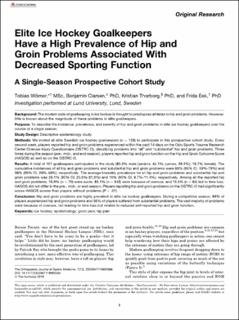| dc.contributor.author | Wörner, Tobias | |
| dc.contributor.author | Clarsen, Benjamin Matthew | |
| dc.contributor.author | Thorborg, Kristian | |
| dc.contributor.author | Eek, Frida | |
| dc.date.accessioned | 2020-05-15T08:47:28Z | |
| dc.date.available | 2020-05-15T08:47:28Z | |
| dc.date.created | 2020-01-06T11:19:24Z | |
| dc.date.issued | 2019 | |
| dc.identifier.citation | The Orthopaedic Journal of Sports Medicine. 2019, 7(12), 2325967119892586. | en_US |
| dc.identifier.issn | 2325-9671 | |
| dc.identifier.uri | https://hdl.handle.net/11250/2654589 | |
| dc.description | This open-access article is published and distributed under the Creative Commons Attribution - NonCommercial - No Derivatives License (http://creativecommons.org/licenses/by-nc-nd/4.0/), which permits the noncommercial use, distribution, and reproduction of the article in any medium, provided the original author and source are credited. You may not alter, transform, or build upon this article without the permission of the Author(s). | en_US |
| dc.description.abstract | Background: The modern style of goalkeeping in ice hockey is thought to predispose athletes to hip and groin problems. However, little is known about the magnitude of these problems in elite goalkeepers. Purpose: To describe the incidence, prevalence, and severity of hip and groin problems in elite ice hockey goalkeepers over the course of a single season. Study Design: Descriptive epidemiology study. Methods: We invited all elite Swedish ice hockey goalkeepers (n ¼ 128) to participate in this prospective cohort study. Every second week, players reported hip and groin problems experienced within the past 14 days on the Oslo Sports Trauma Research Center Overuse Injury Questionnaire (OSTRC-O), classifying problems into “all” and “substantial” hip and groin problems. Three times during the season (pre-, mid-, and end-season), players reported hip and groin function on the Hip and Groin Outcome Score (HAGOS) as well as on the OSTRC-O. Results: A total of 101 goalkeepers participated in the study (83.3% male [seniors, 44.1%; juniors, 39.2%], 16.7% female). The cumulative incidences of all hip and groin problems and substantial hip and groin problems were 69% (95% CI, 59%-79%) and 36% (95% CI, 26%-46%), respectively. The average biweekly prevalence for all hip and groin problems and substantial hip and groin problems was 28.1% (95% CI, 25.0%-31.3%) and 10% (95% CI, 8.7%-11.4%), respectively. Among all the reported hip and groin problems, 16.9% (n ¼ 70) were acute, 83.1% (n ¼ 343) were because of overuse, and 15.5% (n ¼ 64) led to time loss. HAGOS did not differ in the pre-, mid-, or end-season. Players reporting hip and groin problems on the OSTRC-O had significantly worse HAGOS scores than players without problems (P < .01). Conclusion: Hip and groin problems are highly prevalent in elite ice hockey goalkeepers. During a competitive season, 69% of players experienced hip and groin problems and 36% of players suffered from substantial problems. The vast majority of problems were because of overuse, not leading to time loss but related to reduced self-reported hip and groin function. | en_US |
| dc.language.iso | eng | en_US |
| dc.subject | ice hockey | en_US |
| dc.subject | epidemiology | en_US |
| dc.subject | groin pain | en_US |
| dc.subject | hip pain | en_US |
| dc.title | Elite Ice Hockey Goalkeepers Have a High Prevalence of Hip and Groin Problems Associated With Decreased Sporting Function: A Single-Season Prospective Cohort Study | en_US |
| dc.type | Peer reviewed | en_US |
| dc.type | Journal article | en_US |
| dc.description.version | publishedVersion | en_US |
| dc.rights.holder | © The Author(s) 2019 | en_US |
| dc.source.pagenumber | 9 | en_US |
| dc.source.volume | 7 | en_US |
| dc.source.journal | The Orthopaedic Journal of Sports Medicine | en_US |
| dc.source.issue | 12 | en_US |
| dc.identifier.doi | 10.1177/2325967119892586 | |
| dc.identifier.cristin | 1766687 | |
| dc.description.localcode | Seksjon for idrettsmedisinske fag / Department of Sports Medicine | en_US |
| cristin.ispublished | true | |
| cristin.fulltext | original | |
| cristin.qualitycode | 1 | |
